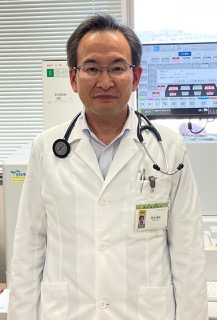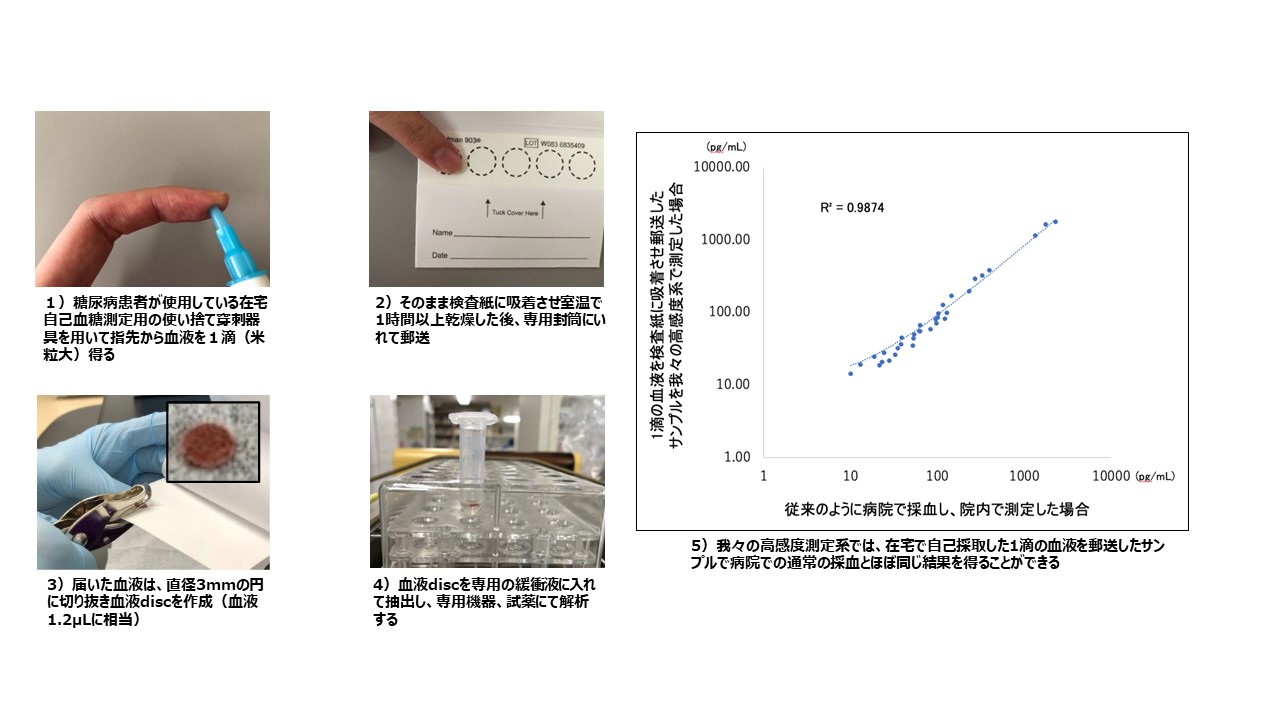Early detection of disease from a single drop of blood.
※The content is current at the time of writing.
Clinical application of highly sensitive measurement systems
Research Overview

Are you not fond of going to hospitals? Reasons given for avoiding hospital visits and medical examinations include “I don’t like having my blood drawn” and “I am too busy with work and child-rearing to go to the hospital. In addition, we have experienced cases of people refraining from seeing a doctor for fear of infection due to the current coronary disaster. What if it were possible to test for disease by simply mailing a drop of blood-soaked test strips or urine from home to a medical institution? What if we could combine these with ICT to provide online medical care? We are currently conducting research to develop such a medical system. An indispensable technology for such a system is a highly sensitive measurement system. We are the first in the world to study the clinical application of this technology to various diseases, and in particular, we are in the pre-practical stage of testing for heart disease.
Research Features
The high-sensitivity measurement system we are currently using in our research is an original method developed by Hashida et al. in our department, which enables measurement of substances in blood and urine with 10 to 1,000 times higher sensitivity than that of conventional tests. There are two main advantages of this higher sensitivity in testing.
First, the increased sensitivity of the test enables the detection of subtle signs of disease that could not be detected by conventional tests because they are below the sensitivity of the test, leading to accurate diagnosis and evaluation of medical conditions. For example, when used to test for autoimmune diseases such as type 1 diabetes and thyroid disease, it is possible to make a positive diagnosis in cases that would have been considered negative by conventional tests and lead to appropriate treatment.
Second, the increased sensitivity of the measurement will enable testing with the same accuracy as a normal blood collection at a hospital, even with a very small amount of sample. For example, we have now succeeded in obtaining test results with almost the same accuracy as a blood sample taken at a medical institution by having a person mail us a test strip soaked with a drop of blood from home, extracting blood components from it using reagents, and analyzing markers for heart disease using an ultra-sensitive measurement system. In addition, many substances in the blood are once filtered through the glomerulus of the kidney and released into the urine, and most of them are reabsorbed in the renal tubules and returned to the body. Therefore, by accurately measuring the small fraction of a substance in the blood that is not reabsorbed by the renal tubules and still appears in the urine, the concentration of this substance in the blood can be estimated. This allows for the identification of disease states in a urine sample without the need for blood sampling.
Future Outlook
Regarding the mailed test for markers of worsening heart disease, we will start research on its application to telemedicine in combination with physical data such as medical interview, blood pressure, weight, and oxygen saturation sent by ICT. For example, hospital visits are often made only once a month, and if a patient’s condition suddenly worsens before the next visit, he or she is urgently hospitalized and incurs medical costs. Therefore, we will initiate a clinical study to prevent emergency hospitalization in high-risk patients with heart disease by predicting early deterioration of the patient’s condition and intervening early, even if the patient is at home, through mailed examination of samples taken at home and regular monitoring of physical data sent by ICT before the next hospital visit. We will start a clinical study to prevent emergency hospitalization by early intervention.
In addition, through joint research with a major Japanese inspection company, we have succeeded in automating this high-sensitivity measurement system ahead of any other in the world. This makes this technology available everywhere. Therefore, we are currently in the process of expanding the types of tests for various diseases using this measurement method.
Attractiveness of the research, message to those who are interested in this research
Medical research often develops from basic research using cell and animal experiments to clinical applications, but I believe that it is only meaningful when it is put to practical use and actually benefits patients. There is no doubt that medical science is advancing day by day, but the reality is that there are far more unresolved issues. Before we are researchers, we are physicians who deal directly with patients every day, and the problems that exist in the medical field directly become the subject of our research. Therefore, clinicians who do not have the research mindset to accurately understand and scientifically analyze patient conditions will miss these problems, or will neglect them even if they are aware of them. In addition, in order to provide better medical care to patients as a clinician, it is necessary to keep acquiring the latest and most advanced knowledge and skills until retirement. For this reason, research experience is very important even for clinicians. Without it, the job of a physician is untenable. To be honest, it is hard work, but if I can give back the results of my research to many patients, it will be an incomparable pleasure. This is what motivates me to continue my medical research.


